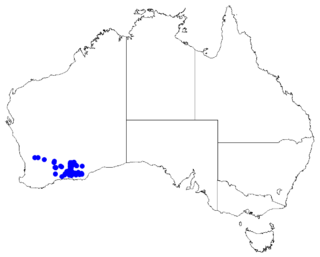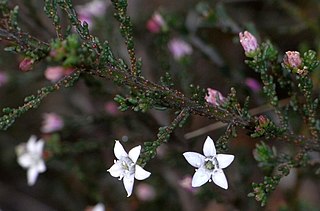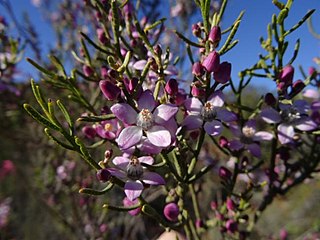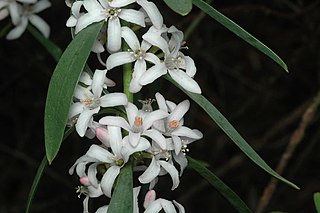
Eriostemon is a genus of flowering plants of the family Rutaceae. It is native to eastern Australia and includes just two species, Eriostemon australasius and Eriostemon banksii. Eriostemon australasius, commonly known as pink wax flower, occurs between Fraser Island and Nowra and is a shrub of heathlands and low open woodlands. Eriostemon banksii is endemic to Cape York Peninsula and is a shrub or small tree occurring in heathland and rainforest margins.

Phebalium bullatum, commonly known as silvery phebalium, desert phebalium or sand phebalium, is a species of shrub that is endemic to southern continental Australia. It is more or less covered with silvery scales and has narrow oblong to narrow wedge-shaped leaves and yellow flowers in umbels of about six.

Philotheca buxifolia is a species of flowering plant in the family Rutaceae and is endemic to New South Wales. It is a shrub with more or less oblong leaves and solitary white to pink flowers arranged singly on the ends of branchlets.

Philotheca trachyphylla, commonly known as rock wax-flower, is a shrub or small tree in the family Rutaceae. The species is endemic to south-eastern Australia. It grows to between 2 and 7 metres high and has warty stems. Leaves are 30 to 50 mm long and 5 to 9 mm wide. They become narrow towards the base and have small warts on the surface. White flowers appear in spring in the leaf axils, singly or in threes.

Boronia fabianoides is a plant in the citrus family, Rutaceae and is endemic to the south-west of Western Australia. It is a compact shrub with many branches, simple, more or less cylindrical leaves and single white, pink or pale blue four-petalled flowers in the leaf axils.

Philotheca angustifolia, commonly known as narrow-leaf wax flower, is a species of flowering plant in the family Rutaceae and is endemic to south-eastern Australia. It is a shrub with small leaves and white flowers with five egg-shaped petals in spring.

Philotheca brucei is a species of flowering plant in the family Rutaceae and is endemic to Western Australia. It is a shrub with cylindrical leaves grooved along the top and in spring, white to pink or mauve flowers with five egg-shaped petals.
Eremophila regia is low-growing shrub with pink to red flowers, small thread-like leaves and that is endemic to Western Australia. It grows on rocky hilltops in the Princess Ranges.

Boronia westringioides is a species of erect shrub that is endemic to a small area in the southwest of Western Australia. It has simple, narrow, sessile leaves and pale pink flowers arranged singly in leaf axils.
Phebalium brevifolium is a species of small shrub that is endemic to Western Australia. It has warty branchlets, sessile, wedge-shaped leaves and up to three white flowers arranged in umbels.
Phebalium clavatum is a species of shrub that is endemic to Western Australia and is more or less covered with silvery scales. It has warty branchlets, more or less circular leaves with a large spherical gland and white flowers arranged singly on the ends of branchlets.
Phebalium verrucosum is a species of shrub that is endemic to New South Wales. It has branchlets densely covered with white scales, narrow elliptic, oblong or linear leaves covered with white scales on the lower side, and umbels of creamy white flowers with silvery or rust-coloured scales on the back of the petals.
Philotheca acrolopha is a species of flowering plant in the family Rutaceae and is only known from a small area in Queensland. It is a shrub with crowded, wedge-shaped leaves and cream-coloured to pale pink flowers.
Philotheca apiculata is a species of flowering plant in the family Rutaceae and is endemic to the south-west of Western Australia. It is a small shrub with narrow club-shaped leaves and small clusters of white to pink flowers on the ends of branchlets.
Philotheca basistyla, commonly known as the white-flowered philotheca, is a species of flowering plant in the family Rutaceae and is endemic to the south-west of Western Australia. It is a small shrub with narrow club-shaped leaves and white flowers arranged singly on the ends of branchlets.
Philotheca brevifolia is a species of flowering plant in the family Rutaceae and is endemic to a small area in south-western New South Wales. It is a spreading shrub with fleshy, sessile, cylindrical leaves and white to pink flowers arranged singly or in small groups on the ends of branchlets.
Philotheca citrina is a species of flowering plant in the family Rutaceae and is endemic to Western Australia. It is a much-branched shrub with curved, narrow club-shaped leaves and pale yellowish green flowers arranged singly on the ends of branchlets.
Philotheca coateana is a species of flowering plant in the family Rutaceae and is endemic to Western Australia. It is a small shrub with small, elliptical leaves and white flowers with a pink midline, arranged singly on the ends of branchlets.

Philotheca conduplicata is a species of flowering plant in the family Rutaceae and is endemic to eastern Australia. It is a shrub with elliptical leaves clustered near the ends of the branchlets and white flowers arranged singly or in two or threes on the ends of the branchlets.
Philotheca cuticularis is a species of flowering plant in the family Rutaceae and is endemic to Queensland. It is a rounded shrub with small, crowded leaves and small white flowers arranged singly on the ends of branchlets.









